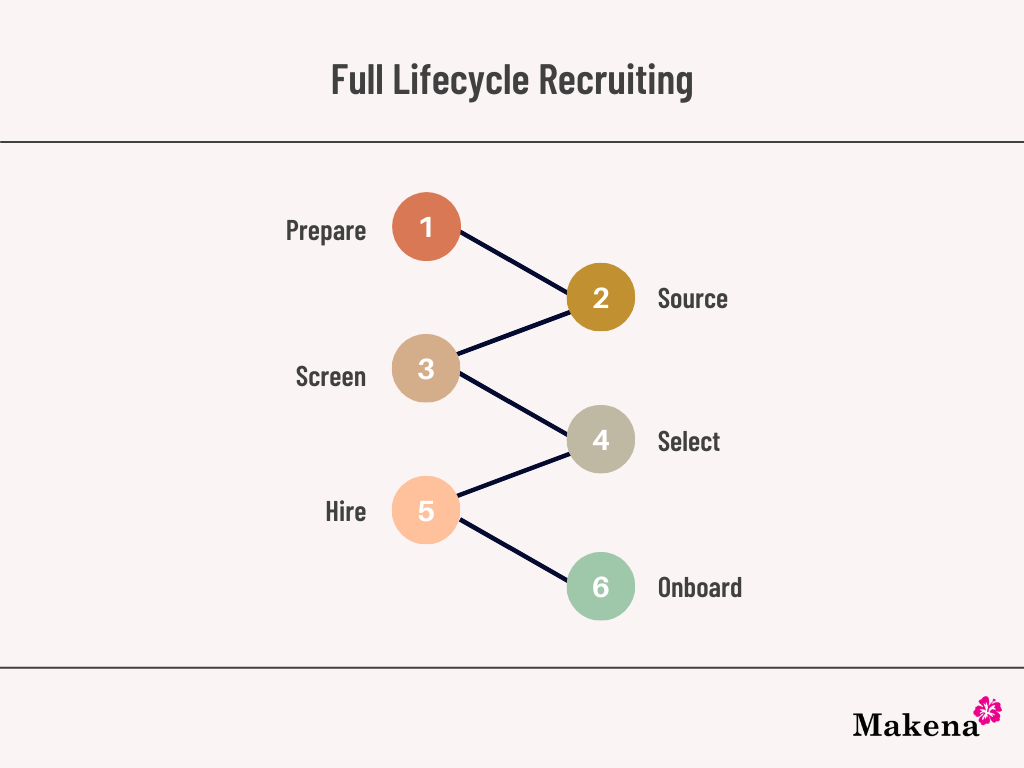Recruiting, as with any process-oriented function, is really the sum of all of its collective parts. While the term “recruiting” tends to be used as all-encompassing, generally when people talk about recruiting, they’re talking about one or more specific steps, or phases, in the “full lifecycle” recruiting process.
So what does that process look like?

With some exception, the majority of recruiters and talent acquisition teams operate under this model. That is to say, this phase-oriented approach is generally accepted standard operating procedure. Each step, or phase, is comprised of any number of tasks that absorb a varying degree of time out of each individual recruiter’s day.
In 2020, recruiting technology platform Yello surveyed 200 professionals in the recruiting, talent acquisition, recruiting operations or staffing space in the United States and asked them which recruiting tasks take the most time in their hiring process. Participants responded by ranking candidate screening as the most time consuming task, followed by conducting interviews, posting jobs, sourcing, and evaluating candidates.

Other tasks that ranked high as time-suckers were scheduling interviews, making a final decision on a candidate, and extending offers.
Over the years, innovative product developers have sought to automate some of these time-consuming tasks with software – not necessarily to replace the human beings conducting the work, but rather to give them utilities that make it easier to do their job, or at least, focus on the more high-impact aspects of their job.
Tools like HireVue, which helps to optimize the screening and interviewing process by leveraging online video, have grown in popularity in recent years, as have job board aggregators, which distribute job postings to any number of job boards with one click.
In 2021, recruiting technology provider Jobvite conducted its annual survey of 817 recruiters in the U.S., resulting in its Recruiter Nation report. Not surprisingly, the desire to update recruiting technology went from 16% in 2017 to 21% in 2021, followed be the need to automate processes and improve efficiency, up from 2% to 10% as a top priority for the recruiters surveyed.

In the same survey, recruiters made it clear that growing their talent pipelines had shifted downward in priority, from 52% in 2017 to 25% in 2021.

This statistic begs the question, what role does talent sourcing (the effort required to build a talent pipeline) play in recruiting in 2022?
Judging by the data from the Yello survey, most recruiters are spending their time screening, interviewing, or evaluating candidates. That likely leaves little time for candidate sourcing, which could lead to thin talent pipelines and candidate flow for high-priority roles that need to be filled.
How are talent acquisition teams then addressing this gap?
The investment in outside recruiters and recruiting agencies jumped from 7% in 2017 to a whopping 27% in 2021, which means US-based organizations are likely to spend millions, if not billions on direct hire placement fees, the standard economic vehicle of recruiting agencies.

The benefit of working with recruiting agencies is obvious: it’s low risk (most agencies are only paid if one of their referrals is hired). It’s also an easy, low-friction way to outsource candidate pipeline building, the only sure-fire way to ensure enough candidates are available to interview and select from. This frees up in-house recruiters to focus on the time-consuming tasks of interviewing and evaluating candidates, without having to worry too much about the “top of the funnel” (candidate flow).
Increasingly, organizations are making internal investments in sourcing by hiring recruiters focused only on that part of the process – the initial discovery, outreach and qualifying of prospective hires through dedicated outbound marketing. This makes sense: “sourcers” operate as lead generation machines, filling can CRM or ATS with qualified leads that their recruiter counterparts can screen and move through interview loops.
Some organizations look to external partners who specialize in candidate sourcing and offer “sourcing-as-a-service” to their clients. In most cases, these firms are well-equipped to handle high-volume sourcing, leveraging modern technology tools and strategies to help fill their client’s pipelines with qualified, prescreened talent for their open and future positions.
How internal recruiting departments manage their candidate sourcing efforts in the future will depend on a number of factors: internal bandwidth and headcount, availability/dependability of external partners, technological innovation and automation.
The closer talent acquisition teams can come to mirroring what is working in marketing relative to demand/lead generation, the more efficient recruiters will be at filling their funnel with qualified candidates in a scalable, repeatable fashion.